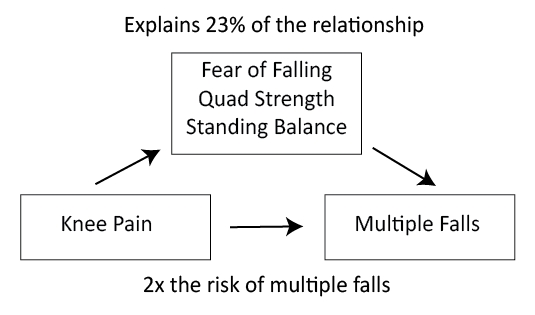By Cameron Hicks
As we age, pain can become an all too familiar problem. While musculoskeletal pain has been shown to increase the risk of having a fall, the evidence is less clear for knee pain specifically. Factors that may contribute to people with knee pain experiencing more falls include joint pathology such as osteoarthritis, pain affecting muscular control or cognitive functions, and short term responses to developing leg pain such as compensatory movements. We sought to investigate whether older adults with self-reported knee pain experienced more falls than those without knee pain and why this may be the case.
We tested 330 older adults aged 70 years and over on a range of physical, psychological and medical factors. Specifically, we assessed, standing balance, leg strength and mobility, depression and anxiety as well as number of medications. One hundred and eighteen (35.5%) participants were categorised as having knee pain. We found older people with knee pain had twice the risk of multiple falls compared to people without knee pain. To determine mediating factors, that is, reasons as to why those with pain fall more often than their painless peers, we identified variables that were associated with pain and falls. Our analyses showed that having a fear of falling explains about 15% of the reason as to why people with pain are more likely to fall. Quadriceps strength was the strongest physical mediator identified, contributing a further 10% to the association with multiple falls. When these mediators are combined, fear of falling, quadriceps strength and standing balance explained almost one-quarter of the relationship between experiencing knee pain and having a higher risk of multiple falls.
Given the large proportion of older people who report pain and the high cost of fall-related injuries, our findings regarding the underlying mechanisms as to how pain may lead to falls have significant public health implications. These mediating factors (fear of falling, leg muscle weakness and poor balance) are easily identified and can be readily treated. Pain can be mediated through appropriate medication prescription and exercise might be an effective way to prevent falls in this vulnerable group of older people. Exercise may be particularly beneficial as targeted exercise can alleviate pain, reduce body weight as well as improve muscle strength and balance – two mediators for the relationship between pain and falls identified in our analysis.

Figure. People in the knee pain group have twice the risk of multiple falls than people with no knee pain (RR=2.0, 95% confidence interval = 1.28 to 3.14). Fear of falling, quadriceps strength and standing balance reduce relative risk by 23% (from RR= 2.0 (univariate) to RR = 1.55).
Publication
Hicks C, Levinger P, Menant JC, Lord SR, Sachdev PS, Brodaty H, Sturnieks DL. Reduced strength, poor balance and concern about falls mediate the relationship between knee pain and fall risk in older people. BMC Geriatr. 2020 Mar 6;20(1):94. doi: 10.1186/s12877-020-1487-2.
About the Author

Cameron Hicks
NeuRA, Sydney, Australia
Cameron is the Project Officer for the New South Wales Falls Prevention Network. He also works as a research assistant at the Falls, Balance, Injury Centre at NeuRA on randomised controlled trials exploring the use of stepping-based exergames as an in home intervention to prevent falls in older adults and in people with multiple sclerosis.
Copyright
© 2020 by the author. Except as otherwise noted, the ISPGR blog, including its text and figures, is licensed under a Creative Commons Attribution-ShareAlike 4.0 International License. To view a copy of this license, visit https://creativecommons.org/licenses/by-sa/4.0/legalcode.
ISPGR blog (ISSN 2561-4703)
Are you interested in writing a blog post for the ISPGR website? If so, please email the ISGPR Secretariat with the following information:
- First and Last Name
- Institution/Affiliation
- Paper you will be referencing

